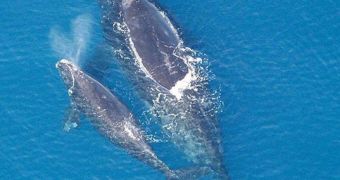US National Oceanic and Atmospheric Administration (NOAA) investigators established in a new study that the sounds emitted by scientific tracking equipment used to monitor whales is affecting the way in which the animals behave. The effect is visible even 120 miles (193 kilometers) away.
The issue with monitoring equipment in use today is that it generates pulsating sounds. These noises are apparently extremely efficient at propagating underwater, about as efficient as whales are in picking them up. These creatures, despite being so massive, have excellent hearing.
Researchers say that their work was only found to be applicable to baleen whales until now, but they don't exclude the possibility of the same scenario being true for other whales as well, Wired reports.
NOAA marine biologist Denise Risch discovered the influence artificial sounds have on whales when she analyzed data collected in waters of Massachusetts during 2006. The majestic creatures sang very little that year, and the expert was eventually able to detect a very low-frequency sound in the water.
This signal was being generated by acoustic sensing equipment installed off the coast of Maine, as part of a different study. The two locations were about 120 miles away from each other, and yet this signal was able to hush up the whales.
In 2008 and 2009, when the Ocean Acoustic Waveguide Remote Sensing instruments used off the coasts of Maine were turned off, whales in Massachusetts waters began singing a lot more often. The main implication here is that low-frequency sounds silence the whales, by stopping their songs.
“It’s fascinating that we saw this behavioral response over such a large distance,” says Risch, who is also the lead author of a new paper detailing the finding. The work appears in the January 11 issue of the peer-reviewed journal PLoS ONE, which is edited by the Public Library of Science.
Other scientists welcomed the research, but warned that a lot more work needs to be done before a clear conclusion can be reached. “It’s important to be concerned about the whales, but it’s also important to get it right,” explains Nicholas Makris.
The mechanical engineer, who is also the director of the Laboratory for Undersea Remote Sensing at the Massachusetts Institute of Technology (MIT), was not a part of the work. However, he explains that a variation in whale numbers may have been responsible for the 2006 silence.
Until a way to conduct accurate tallies of annual whale numbers is developed, this type of research will always be plagued by uncertainty, Makris comments.

 14 DAY TRIAL //
14 DAY TRIAL //